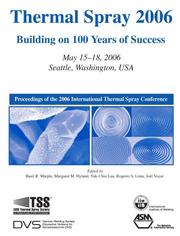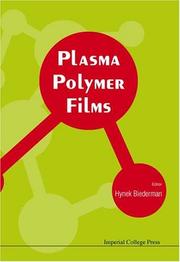| Listing 1 - 10 of 19 | << page >> |
Sort by
|
Book
ISBN: 1615032622 Year: 2004 Publisher: Materials Park, OH : ASM International,
Abstract | Keywords | Export | Availability | Bookmark
 Loading...
Loading...Choose an application
- Reference Manager
- EndNote
- RefWorks (Direct export to RefWorks)

ISBN: 1615031219 9781615031214 0871708523 9780871708526 0871708361 9780871708366 Year: 2006 Publisher: Materials Park, OH ASM International
Abstract | Keywords | Export | Availability | Bookmark
 Loading...
Loading...Choose an application
- Reference Manager
- EndNote
- RefWorks (Direct export to RefWorks)
Book

ISBN: 1615032304 9781615032303 0871707373 9780871707376 Year: 2001 Publisher: Materials Park, OH : ASM International,
Abstract | Keywords | Export | Availability | Bookmark
 Loading...
Loading...Choose an application
- Reference Manager
- EndNote
- RefWorks (Direct export to RefWorks)
Book
ISBN: 9811927413 9811927421 Year: 2022 Publisher: Singapore : Springer Nature Singapore Pte Ltd.,
Abstract | Keywords | Export | Availability | Bookmark
 Loading...
Loading...Choose an application
- Reference Manager
- EndNote
- RefWorks (Direct export to RefWorks)
Plasma spraying. --- Spraying, Plasma --- Metal coating --- Plasma jets --- Protective coatings
Book
ISBN: 9535161601 9535103490 Year: 2012 Publisher: Rijeka, Croatia : InTech,
Abstract | Keywords | Export | Availability | Bookmark
 Loading...
Loading...Choose an application
- Reference Manager
- EndNote
- RefWorks (Direct export to RefWorks)
Recently, plasma spray has been received a large number of attentions for various type of applications due to the nature of the plasma plume and deposition structure. The plasma gas generated by the arc, consists of free electrons, ionized atoms, some neutral atoms, and undissociated diatomic molecules. The temperature of the core of the plasma jet may exceed up to 30,000 K. Gas velocity in the plasma spray torch can be varied from subsonic to supersonic using converging-diverging nozzles. Heat transfer in the plasma jet is primarily the result of the recombination of the ions and re-association of atoms in diatomic gases on the powder surfaces and absorption of radiation. Taking advantages of the plasma plume atmosphere, plasma spray can be used for surface modification and treatment, especially for activation of polymer surfaces. I addition, plasma spray can be used to deposit nanostructures as well as advanced coating structures for new applications in wear and corrosion resistance. Some state-of-the-art studies of advanced applications of plasma spraying such as nanostructure coatings, surface modifications, biomaterial deposition, and anti wear and corrosion coatings are presented in this book.
Plasma spraying. --- Spraying, Plasma --- Metal coating --- Plasma jets --- Protective coatings --- Biomedical engineering
Periodical
ISSN: 15441016 10599630 Year: 1992 Publisher: [Materials Park, OH] : ASM International
Abstract | Keywords | Export | Availability | Bookmark
 Loading...
Loading...Choose an application
- Reference Manager
- EndNote
- RefWorks (Direct export to RefWorks)
Metal spraying --- Plasma spraying --- Métallisation au pistolet. --- Projection au plasma. --- Spraying, Plasma --- Spraying, Metal --- Spraying, Thermal --- Thermal spraying --- Metal coating --- Plasma jets --- Protective coatings --- Surface hardening
Book
Year: 2021 Publisher: Basel, Switzerland MDPI - Multidisciplinary Digital Publishing Institute
Abstract | Keywords | Export | Availability | Bookmark
 Loading...
Loading...Choose an application
- Reference Manager
- EndNote
- RefWorks (Direct export to RefWorks)
TBC materials in the hot components of a gas turbine are exposed to extremely harsh environments. Therefore, the evaluation of various environmental factors in applying new TBCs is essential. Understanding the mechanisms for degradation which occur in comprehensive environments plays an important role in preventing it and improving the lifetime performance. The development of novel coating techniques can also have a significant impact on lifetime performance as they can alter the microstructure of the coating and alter the various properties resulting from it. This Special Issue presents an original research paper that reports the development of novel TBCs, particularly the application of advanced deposition techniques and novel materials.
degradation --- high mechanical fatigue --- hot gas path components --- gas turbine lifetime --- gas turbine blade --- ANNs --- passive methods --- building energy --- internal covering --- thermal barrier coating (TBC) --- BaLa2Ti3O10 --- molten salt corrosion --- corrosion mechanisms --- crack healing --- encapsulation --- healing agent --- thermal barrier coating --- thermal durability --- cyclic thermal fatigue --- crack growth --- initial crack length --- failure --- hydrogenated amorphous silicon films --- high temperature oxidation --- super-low friction --- plasma spray–physical vapor deposition --- thermal stability --- thermal barrier coatings --- bond coat species --- electron beam-physical vapor deposition --- cyclic thermal exposure --- plasma spraying --- SrZrO3 --- TBC --- CMAS --- luminescence --- high temperature wear behavior --- dry sliding wear --- CoNiCrAlY --- detonation gun (D-gun) --- supersonic plasma spraying (SSPS)

ISBN: 128186644X 9786611866440 1860945384 9781860945380 9781860944673 1860944671 Year: 2004 Publisher: London : Imperial College Press,
Abstract | Keywords | Export | Availability | Bookmark
 Loading...
Loading...Choose an application
- Reference Manager
- EndNote
- RefWorks (Direct export to RefWorks)
Plasma Polymer Films examines the current status of the deposition and characterization of fluorocarbon-, hydrocarbon- and silicon-containing plasma polymer films and nanocomposites, with plasma polymer matrix. It introduces plasma polymerization process diagnostics such as optical emission spectroscopy (OES, AOES), and describes special deposition techniques such as atmospheric pressure glow discharge. Important issues for applications such as degradation and stability are treated in detail, and structural characterization, basic electrical and optical properties and biomedical applications are discussed.
Plasma polymerization. --- Polymers. --- Polymere --- Polymeride --- Polymers and polymerization --- Macromolecules --- Glow discharge polymerization --- Plasma-induced polymerization --- Plasma-state polymerization --- Polymerization --- Plasma polymerization --- Polymers --- Plasma spraying --- Thin films --- Polymères. --- Polymérisation sous plasma. --- Projection au plasma. --- Couches minces. --- Polymères. --- Polymérisation sous plasma.
Book
Year: 2021 Publisher: Basel, Switzerland MDPI - Multidisciplinary Digital Publishing Institute
Abstract | Keywords | Export | Availability | Bookmark
 Loading...
Loading...Choose an application
- Reference Manager
- EndNote
- RefWorks (Direct export to RefWorks)
Ceramic materials in the form of coatings can significantly improve the functionality and applications of other engineering materials. Due to a wide range of controllable features and various deposition methods, it is possible to create tailored substrate–coating systems that meet the requirements of modern technologies. Therefore, it is crucial to understand the relationships between the structures, morphology and the properties of ceramic coatings and expand the base of scientific knowledge about them. This book contains a series of fourteen articles which present research on the production and properties of ceramic coatings designed to improve functionality for advanced applications.
photocatalytic coatings --- solidification --- plasma spraying --- TiO2 --- microstructure --- LDPE --- RF CVD --- doped DLC structure --- wettability --- biocompatibility --- ceramic coating --- anti-oxidation --- SiO2@Al additive --- carbon steel --- calcium hydroxyapatite --- sol-gel synthesis --- thin films --- spin coating --- surface roughness --- simulated body fluid --- SiO2 coatings --- sol-gel --- Zn doping --- antibacterial coatings --- hydrophobic coatings --- Ni–Cr alloy --- Ti(C, N) coatings --- ion release --- atmospheric plasma spraying --- Al2O3 --- Cr2O3 --- sliding wear --- phase transformation --- reactivity --- sol-gel coating --- corrosion resistance --- cells viability --- hydrophilic coating --- nitriding --- low friction --- piston ring --- micron-/nano-grain coatings --- nanoindentation size effect --- trans-scale mechanics theory --- SiC coatings --- oxide fibers --- chemical vapor deposition --- deposition mechanism --- thickness control --- silicon carbon-nitride --- silicone carbon-oxide --- PECVD method --- inhomogeneous optical filters --- gradient interference filters --- organosilicon precursors --- alumina coating --- sol–gel --- composite coating --- graphene oxide --- graphene nanoplatelets (GNP) --- rGO --- adiabatic shear instability (ASI) --- cold spray --- titanium dioxide --- bonding mechanism --- adhesion strength --- substrate deformation --- amorphous interface layer --- n/a --- Ni-Cr alloy
Book
Year: 2019 Publisher: MDPI - Multidisciplinary Digital Publishing Institute
Abstract | Keywords | Export | Availability | Bookmark
 Loading...
Loading...Choose an application
- Reference Manager
- EndNote
- RefWorks (Direct export to RefWorks)
Palladium (Pd)-based membranes have received a great deal of attention from both academia and industry thanks to their ability to selectively separate hydrogen from gas streams. The integration of such membranes with appropriate catalysts in membrane reactors allows for hydrogen production with CO2 capture that can be applied in smaller bioenergy or combined heat and power (CHP) plants, as well as in large-scale power plants. Pd-based membranes are therefore regarded as a Key Enabling Technology (KET) to facilitate the transition towards a knowledge-based, low-carbon, and resource-efficient economy. This Special Issue of the journal Membranes on “Pd-based Membranes: Overview and Perspectives” contains nine peer-reviewed articles. Topics include manufacturing techniques, understanding of material phenomena, module and reactor design, novel applications, and demonstration efforts and industrial exploitation.
hydrides --- membrane --- Pd-Ag membranes --- electroless plating --- defect distribution --- hydrogen --- hydrogen production --- suspension plasma spraying --- chemical potential --- review --- grain boundary --- manufacturing --- palladium --- LOHC --- palladium alloy --- open architecture --- PdAg-membrane --- hydrogen permeation --- modelling --- membranes --- pore mouth size distribution --- MLLDP --- solubility --- closed architecture --- demonstration --- Pd-based membrane --- methanol steam reforming --- activity --- micro reactor --- microstructured --- hydrogen separation --- membrane reactors --- Pd alloy --- hydrogen purification --- palladium-based membrane --- gas to liquid --- dense Pd membrane --- propylene --- heat treatment --- surface characterization --- porous membrane --- multi-stage --- membrane reactor --- dehydrogenation
| Listing 1 - 10 of 19 | << page >> |
Sort by
|

 Search
Search Feedback
Feedback About
About Help
Help News
News